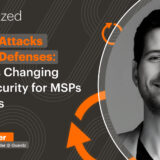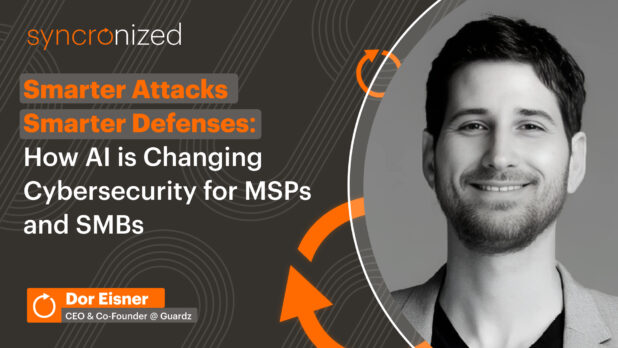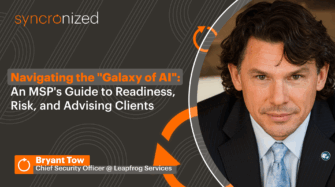Table of contents
Episode Summary
In this episode of Syncronized, host Brandon Garcin sits down with Dor Eisner, CEO and Co-Founder at Guardz. Together, they explore the changing landscape of cybersecurity for managed service providers (MSPs) as artificial intelligence becomes a daily reality for both attackers and defenders.
Dor shares why AI is a double-edged sword in the security world, driving up both the speed of attacks and the tools available for defense. He explains how the shift from siloed tools to unified data lakes helps MSPs make sense of the flood of alerts, automate threat detection, and respond faster. Dor also highlights the importance of people and process, not just technology, in building a modern, resilient operation.
The conversation ends with a look at the future: connected security ecosystems, the evolving role of technicians, and practical steps for MSPs to build a culture that embraces AI. Dor urges leaders to inspire their teams and learn from other industries, setting the stage for smarter, more effective security.
Guest-at-a-glance
💡 Name: Dor Eisner
💡 What he does: CEO & Co-Founder
💡 Company: Guardz
💡 Noteworthy: Known for building unified security platforms that help MSPs use AI and automation to manage risk, streamline operations, and secure small businesses at scale.
💡 Where to find him: LinkedIn
Key Insights
Unifying Data Is the Foundation of Modern Security
Fragmented security tools create noise and slow response times. Unifying alerts, logs, and signals into a single data lake is the only way to build context and make effective use of artificial intelligence. With everything in one place, teams can automate alert triage, spot patterns that cross tool boundaries, and cut response times. This shift also makes it easier for junior staff to operate at a higher level—AI can do the heavy lifting, while humans focus on strategy and complex cases. In a landscape where threats move fast, and small businesses are frequent targets, building a single source of truth isn’t optional. It’s the foundation for both security and efficiency. Teams that invest in integration now will have a practical edge as attacks get more complex and the need for speed grows.
AI Won’t Replace Technicians—It Will Redefine Their Roles
AI tools can handle repetitive, low-level tasks like sifting through phishing alerts or cleaning up basic security incidents. This automation frees up technicians to focus on higher-value work: analyzing complex threats, optimizing processes, and supporting business growth. The real opportunity is not in reducing headcount, but in making the most of existing talent. As AI takes over the grunt work, technicians can become problem-solvers, strategists, and trusted advisors. This shift also raises the bar for hiring and training—teams need to understand both security and how to use automation wisely. The best results come when people and AI work together, each playing to their strengths. In the coming years, MSPs that nurture this partnership will be better prepared to handle both growing workloads and evolving threats.
AI and Automation Demand a Culture Shift—Not Just New Tools
Building an effective AI-powered operation takes more than buying new software. Teams need to create a culture that embraces change, encourages curiosity, and learns from other industries. Simply telling technicians to “use AI” won’t move the needle. Leaders should expose their teams to new ideas, invite them to experiment, and make them part of the journey. This approach fosters buy-in and surfaces creative solutions. The culture shift also means rethinking roles, processes, and training—not only in security, but across every part of the business. As AI becomes a core layer in IT service delivery, the gap will widen between those who adapt and those who resist. MSPs that build a learning culture now will be able to deploy automation more effectively, respond faster to market changes, and keep clients protected in a rapidly shifting landscape.
Listener Takeaways
The Double-Edged Sword of AI in Cybersecurity
AI is transforming both sides of the cybersecurity battle. While managed service providers (MSPs) turn to AI and automation to handle rising workloads and tighten operations, threat actors do the same to scale up attacks. The dark web now brims with attack-as-a-service tools, making it easy for even novice cybercriminals to launch targeted campaigns. As a result, small businesses face increased risk, and MSPs must balance the promise of AI with its threats. The discussion sets the stage for why automation is now essential for both offense and defense in IT security.
The Growing Challenge of Siloed Security Tools
Many MSPs rely on multiple security tools, each focused on a single threat vector. This fragmented approach makes it tough to connect the dots and respond quickly. As threats move faster, old methods—where technicians work separately on different tools—fall short. The need for context across systems has never been greater. The highlight underscores why bringing tools and data together isn’t just a technical upgrade; it’s about giving teams a fighting chance against evolving attacks.
AI’s Role in Reducing Alert Overload
The flood of security alerts can overwhelm even large teams, and many MSPs lack the bandwidth to investigate every signal. AI-driven automation offers hope by filtering noise and surfacing real threats. When used well, it can help less-experienced technicians step up, even as hiring experienced talent gets harder. Still, letting automation drive decisions brings risks—AI can get things wrong. This section explores the tension between efficiency and accuracy as teams rethink how they handle growing security data.
Preparing Teams for the AI-Powered Future
Adopting automation and AI isn’t just about technology—it’s about people and culture. Success depends on exposing teams to new ideas, encouraging curiosity, and making space for learning. Telling technicians to “just use AI” rarely works. Instead, leaders should involve staff in exploring new approaches and inspire them by sharing examples from other sectors. This creates buy-in and paves the way for smarter, more resilient operations. The discussion closes with a call to action: MSPs that invest in a learning culture will be better prepared for the next wave of change.

Syncronized is the MSP podcast that drives MSP growth, from startup to scale-up. In each episode, we dive into the topics that matter most to IT providers, such as automation, AI, service delivery and profitability. Join us as we engage with experts and gain hands-on insights and practical advice you can directly apply to propel your business forward.
Share













